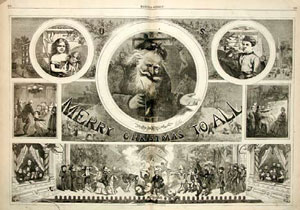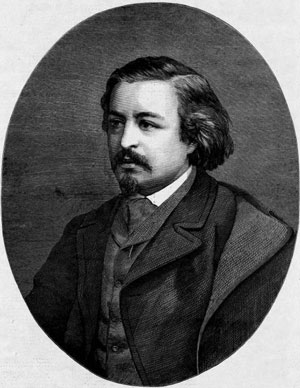
Santa Claus. There is hardly a more All-American image than that of a tall, bewhiskered, overweight Santa, with rosy red cheeks, and a smile playing about his lips. In his red suit trimmed with white and dark boots, Santa’s likeness is instantly recognizable, no matter the setting.
What most people don’t know is that much of this All-American image was created by a German artist named Thomas Nast. Born on September 27, 1840 in Landau, Germany, Nast came to the United States in 1846 with his mother. Nast grew into a good-humored person with a fondness for whimsy.
Especially dear to him were his childhood memories of Christmas. Those had been magical times, filled with love, laughter, and the mystery of the holiday season that is so essential for its embracing by both children and adults.
At age 15, Nast’s talent for drawing landed him a job as a cartoonist for the weekly magazine Frank Leslie’s Illustrated Newspaper, a forerunner of the modern news magazine. He later moved to Harper’s Weekly, a similar publication. He became the most influential cartoonist in the United States.
If he came out against something or somebody, his cartoons served as a powerful weapon. As New York City’s William “Boss” Tweed once said, “I don’t care so much what the papers write about me — my constituents can’t read. But damn it, they can see pictures!”
Nast was responsible for the downfall of Tweed’s powerful Tammany Hall political machine. Nast also popularized the donkey and elephant as the symbols for the Democratic and Republican political parties. His was a loud voice that never spoke.
As the nation became increasingly embroiled in the bloody Civil War in the early 1860s, Nast plunged into the fray at Harper’s; time and again, the patriotic Nast’s poignant cartoons hit their mark, bringing the evils of the Confederacy, and the longing of Northern soldiers to be reunited with hearth and home to readers everywhere. He was a great champion of the Union cause. President Abraham Lincoln called him “our best recruiting sergeant.”
 In December 1862, Nast got an opportunity to do something different than draw about war, death, and/or society’s ills. The magazine wanted a Christmas-themed piece, and Nast jumped at the opportunity.
In December 1862, Nast got an opportunity to do something different than draw about war, death, and/or society’s ills. The magazine wanted a Christmas-themed piece, and Nast jumped at the opportunity.
Called “Santa In Camp,” the illustration combined reality with Nast’s penchant for whimsy. It showed Santa sitting on a Union Army wagon, dressed in a stars and stripes suit trimmed with fur. He was handing out Christmas gifts (including copies of Harper’s) to Union soldiers.
In the middle of the magazine was a two-page Christmas-themed spread. Among the drawings was one of Santa with his sleigh and reindeers, and another of him about to go down a chimney.
Now that Nast had gotten a-hold of him, the short, lean, clean-shaven Santa usually depicted at that time, was in for a radical makeover. (In one 1837 painting, Santa looked positively evil.)
Most importantly, Nast had to create Santa so that children — and for that matter, adults — wouldn’t be afraid to meet him in a dark alley. Drawing on a stereotype of the time, Nast made Santa large and pleasingly plump, doing away with the imp-like version.
He changed Santa’s facial expression to one that crinkled the corners of his eyes, and raised the corners of his mouth, as if he was just about to laugh. He also gave him a wreath of holly to wear around his neck. Nast also drew a whole team of reindeer to pull Santa’s sleigh rather than just one, and popularized the concept of hanging stockings by the fireplace.
 Other classic attributes that Nast gave Santa included a book that listed the names of good and bad children, a telescope that allowed him to see who was naughty, and who was nice, and a toy-making workshop. (The location was not specified as the North Pole. That came later, and it was not Nast’s idea.) Now when parents said, “Santa’s watching,” American kids knew it to be true: They had seen how he did it. Nast even gave Santa a telephone for better communication, when that new-fangled device made its appearance.
Other classic attributes that Nast gave Santa included a book that listed the names of good and bad children, a telescope that allowed him to see who was naughty, and who was nice, and a toy-making workshop. (The location was not specified as the North Pole. That came later, and it was not Nast’s idea.) Now when parents said, “Santa’s watching,” American kids knew it to be true: They had seen how he did it. Nast even gave Santa a telephone for better communication, when that new-fangled device made its appearance.
Recognizing a good behavioral tool when they saw it, parents inundated Harper’s with reprint requests. However, when a publisher of color children’s books asked for the drawings to put in a full-color book, it led to a dilemma for Nast. His drawings had always been black-and-white, but in his mind, Santa had always worn a tan suit — much too mundane for a color book. So to make the suit stand out, he made it bright red and trimmed it in white fur. Thus, another iconic image arrived on the scene.
Every Christmas, Nast refined his vision of Santa Claus. Nast, a small child himself at heart, loved everything about Christmas. At home, he would often make and arrange large paper dolls parading around his children’s presents.
He also found inspiration from his kids; their faces appeared in many of his Christmas drawings. In 1890, Nast assembled many of his Christmas drawings into a special book called Thomas Nast’s Christmas Drawings for the Human Race. It was a great success. However, Nast’s tenure with Harper’s had ended a few years earlier, and by 1890 financial mistakes left Nast plagued with financial problems that would haunt him for the remainder of his life.
Down on his luck, Nast gratefully accepted an offer from President Theodore Roosevelt in 1902 to become Counsel General to Ecuador, even though he was terrified of the tropical country’s yellow fever epidemics. He had good reason to be afraid.
Thomas Nast died of yellow fever on December 7, 1902 in Guayaquil, Ecuador. In an eerie case of foreshadowing, in his desk at his Morristown New Jersey home, was found a picture of Nast’s drawing implements wrapped in black ribbon that he had drawn before going to Ecuador.
He had known before he left that he would never see them again. But death could not still the artistic vision that lived on beyond the years.
